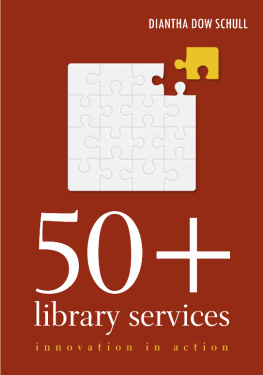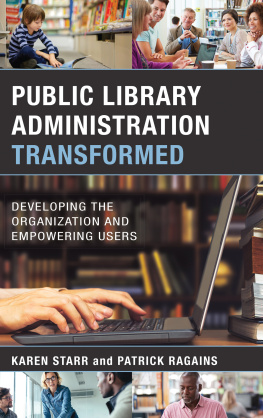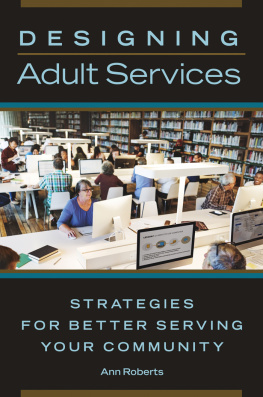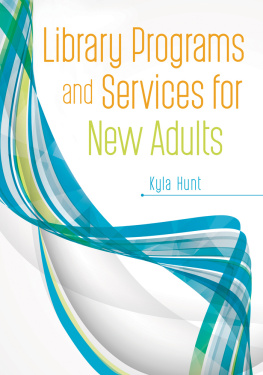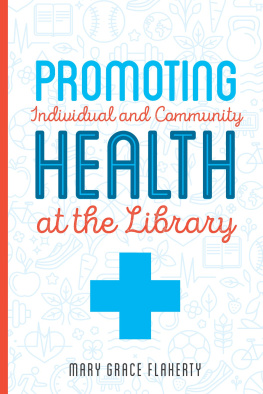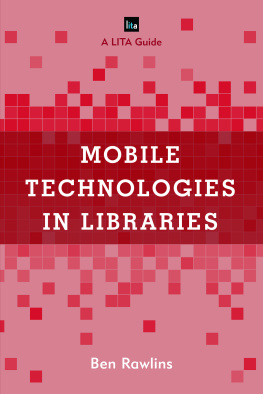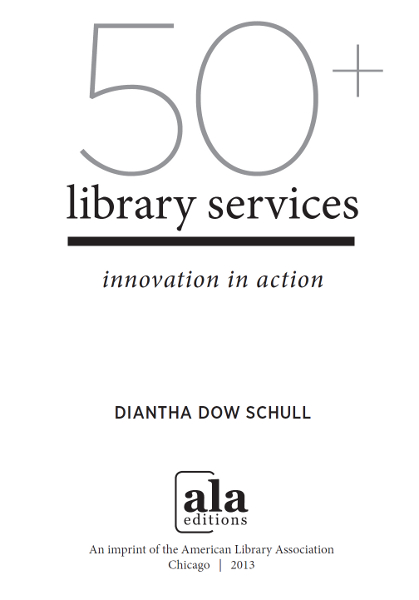
ALA Editions purchases fund advocacy, awareness, and accreditation programs for library professionals worldwide.
Diantha Dow Schull is an advisor to libraries, museums, and foundations on organizational and program development. She was formerly president of Libraries for the Future and the Americans for Libraries Council. Earlier, she was executive director of the French-American Foundation, director of exhibitions and education at the New York Public Library, director of interpretive programs at the Library of Congress, and assistant director of the Museum Aid Program of the New York State Council on the Arts. Schull serves on the board of the Connecticut Humanities Council. She is the author of numerous articles on cultural institutions and was coeditor, with Pauline Rothstein, of Boomers and Beyond: Reconsidering the Role of Libraries (2010).
2013 by the American Library Association. Any claim of copyright is subject to applicable limitations and exceptions, such as rights of fair use and library copying pursuant to Sections 107 and 108 of the U.S. Copyright Act. No copyright is claimed for content in the public domain, such as works of the U.S. government.
Extensive effort has gone into ensuring the reliability of the information in this book; however, the publisher makes no warranty, express or implied, with respect to the material contained herein.
ISBNs: 978-0-8389-1119-8 (paper); 978-0-8389-9647-8 (PDF); 978-0-8389-9653-9 (ePub); 978-0-8389-9654-6 (Kindle). For more information on digital formats, visit the ALA Store at alastore.ala.org and select eEditions.
Library of Congress Cataloging-in-Publication Data
Schull, Diantha Dow.
50+ library services : innovation in action / by Diantha Dow Schull.
pages cm
Includes bibliographical references and index.
ISBN 978-0-8389-1119-8
1. Libraries and older peopleUnited States. 2. Adult services in public librariesUnited States. I. Title. II. Title: Fifty plus library services.
Z711.92.A35S38 2013
027.62'2dc23 2012023720
Cover design by Karen Sheets de Gracia. Image Khvost/Shutterstock. Inc.
Contents
There is a new language addressing this population and it is not senior. It is about being a mature adult, the third age, the next challenge, productive aging, and much more.... We have a lot of ground to cover.
James Wellbourne, former city librarian, New Haven Free Public Library
T his volume documents an important period in the evolution of American library services for older adults, the years 20052011. Two milestone events bookend these years: the Designs for Change: Libraries and Productive Aging Leadership Forum held in Washington, D.C., in 2005 and the completion of the IMLS Western States Fellowship program in June 2011. Between these two events librarians began to recognize that traditional concepts of aging and traditional approaches to senior services in libraries were outmoded and needed rethinking for the twenty-first century.
The period 20052011 can be characterized as a turning point, a time when librarians started to respond to the aging of America. They became aware of new research on aging and older adults, indicating new possibilities for learning, creativity, and community engagement, and they became aware of the emergence of a new life stage, a period between full-time work or parenthood and the onset of frailty and dependency toward the end of life. Adults in this life stage, including baby boomers, did not seem to fit the professions traditional definitions of seniors. Many librarians started to reexamine the professions traditional definitions of seniors and to rethink approaches for organizing and delivering services to baby boomers and other active older adults. Some even started to coin a new term for a new midlife stage: 50+ services.
During these years the development of 50+ services was encouraged by library leaders in several states, notably Arizona, California, Connecticut, and Massachusetts. Using the tools for institutional change at their disposalprofessional development, grants, recognition, and leadership activitiesstate librarians introduced the professionals in their states to current research on older adult development and provided incentives to translate this research into new models of practice. In California a large-scale initiative started in 2008 that included training, funding, and technical assistance. That initiative, Transforming Life After 50, has inspired new services, programs, and partnerships all across the state and led to wider regional work with other western states to build the capacity of librarians to work with todays 50+ adults.
At the same time, a handful of librarians were moved to experiment in their local libraries. Some had attended the Libraries for the Future Lifelong Access Libraries Leadership Institute, which was held for three years (20062008) at the University of North Carolina. Institute fellows gained new perspectives on aging, learned about changes taking place in other professions, and shared ideas about how to transform library services to help boomers through midlife transitions and unexpected bonus years. Other librarians interested in 50+ services were themselves midlife adults who recognized the lack of relevant library programming for the growing numbers of graying but active adults entering their libraries. No matter their inspiration, these forward-thinking professionals understood the potential for libraries to position themselves as essential centers for learning, creativity, encore careers, and community engagement. Because of their insights and their commitment, a handful of libraries around the country, which I refer to as 50+ Beacon Libraries, are now providing instructive models of change.
As a result of these developments a new movement for older adult services has begun to emerge, a movement that portends restructuring of adult services across the lifespan and promises new relationships between libraries and their midlife constituents. Today, that movement is still in its infancy. The changes taking place are decentralized, uneven, and sometimes invisible even to library colleagues and patrons. Collectively, however, they offer evidence of institutional and professional change.
50+ Library Services: Innovation in Action is intended not only to capture the status of the new movement at a point in time but to help advance that movement. It looks at the societal trends driving change in libraries and considers the implications of these trends for current services and programs. It highlights 50+ initiatives carried out in what I call Leading-Edge States and profiles eleven institutions that have taken the lead as 50+ Beacons in their communities and in the profession. Additionally, it offers examples of the many projects and programs taking place in libraries across the country that can be adapted by creative librarians in other institutions and community settings. Thus, it can provide a foundation for planning and practice for library leaders, practitioners, volunteers, and other current or potential funders. It will also be useful to library educators as a text for use in academic courses or professional development programs on 50+ services.
50+ Library Services has integrity as a holistic work. It can be read from beginning to end, with each chapter providing a snapshot of specific, topical programs or services that contribute to the whole. Alternatively, readers seeking to understand the relationship of libraries to particular themes, such as creative aging or financial planning, may turn first to the relevant chapter.

